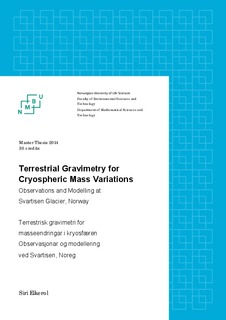| dc.contributor.author | Eikerol, Siri | |
| dc.date.accessioned | 2014-09-08T09:36:30Z | |
| dc.date.available | 2014-09-08T09:36:30Z | |
| dc.date.copyright | 2014 | |
| dc.date.issued | 2014-09-08 | |
| dc.identifier.uri | http://hdl.handle.net/11250/218924 | |
| dc.description.abstract | Glacier ice stores about 75 % of the worlds freshwater, a basic resource for life, and a primary medium through which climate change affects the Earth's ecosystem and its habitants. Glaciers are sensitive climate change indicators, and in Norway research on glacier mass balance is of interest e.g. in the scientific field of glaciology as well as for hydro power production companies.
This thesis presents a method for observing mass change of glacier ice on Engabreen drainage basin, a part of Western Svartisen ice cap, Norway. The Norwegian Water Resources and Energy Directorate operates a subglacial laboratory situated below 200 m of ice. The laboratory area is a part of a long system of water tunnels leading melt water from the glacier bed to hydro power production. The site gives opportunities for measuring very precise gravity values in laboratory conditions with an absolute gravimeter. Relative gravity measurements were conducted in the water tunnel leading from one side of the glacier outlet tongue to the other.
Field work was conducted during March 2014 in order to establish gravity stations for facilitating later missions and develop a time series for the given conditions. Twenty one gravity stations were surveyed and marked through the specified part of the tunnel system. An absolute gravity value of 982202709.74 μGal with an uncertainty of ± 3.47 μGal was measured at the laboratory site and the relative measurements showed uncertainties of around 10 μgal. Modelled effects of different ice surface changes, and the uncertainties of the gravity measurements, give an opportunity to detect changes of ± 0.05 m on the glacier surface.
Temporal masses in the tunnel system were measured during the field work and the effect on nearby gravity stations was modelled. For forthcoming missions, these effects can be reduced if other conditions occur. The present work describes a method for determining a more precise bedrock topography, which may give more accurate results of the gravity effects.
With the results presented additional data can be combined with established methods for mass measurements and give more precise results in interest of hydro power production and for scientific purposes related to climatic change. | nb_NO |
| dc.language.iso | eng | nb_NO |
| dc.publisher | Norwegian University of Life Sciences, Ås | |
| dc.rights | CC0 1.0 Universal | * |
| dc.rights.uri | http://creativecommons.org/publicdomain/zero/1.0/ | * |
| dc.title | Terrestrial gravimetry for cryospheric mass variations : observations and modelling at Svartisen glacier, Norway | nb_NO |
| dc.title.alternative | Terrestrisk gravimetri for masseendringar i krysfæren : observasjonar og modellering ved Svartisen, Noreg | nb_NO |
| dc.type | Master thesis | nb_NO |
| dc.subject.nsi | VDP::Technology: 500::Information and communication technology: 550::Geographical information systems: 555 | nb_NO |
| dc.source.pagenumber | 95 | nb_NO |
| dc.description.localcode | M-GEOM | nb_NO |

